
Home |
||
|---|---|---|
Before the exhibitions |
Eight Impressionism exhibitions |
After the exhibitions |
|
||
Camille Corot
Jean-Baptiste Camille Corot
* 16. July 1796 in Paris; † 22. February 1875 in Paris
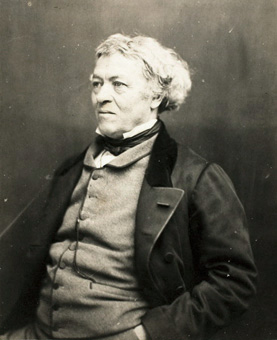
Corot - Photo by Nadar
The work left behind by the French painter Camille Corot is characterised by its naturalness, impartiality and naturalness. The richness and beauty of his numerous works keep him at the forefront of European painting.
Corot was born in Paris in 1796.
After secondary school in Rouen and an apprenticeship as a draper, he decided to train as an artist. His first stop was to learn historical landscape painting in the style of Nicolas Poussin and Claude Lorraine. However, he began his own nature studies early on, for example in Fontainebleau. He travelled to Italy three times: the first trip took him to Venice, Rome and Naples from 1825 to 1828. The second trip in 1834 began in Florence and then took him back to Venice. He later travelled to Lake Garda and Lake Como. The journeys had a strong influence on his art. There he discovered the beauty of nature through the southern light and freed himself from the shackles of academic guidelines.
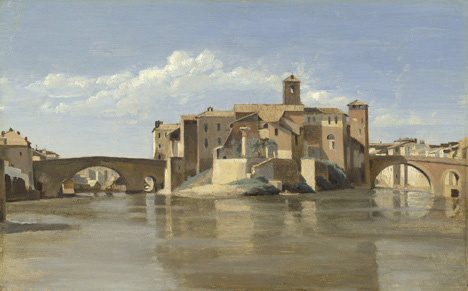
L'île et le pont de San Bartolomeo, Rome
1825/28 - 27 x 43 cm - Oil on paper laminated on canvas
National Gallery of Art, Washington, USA >
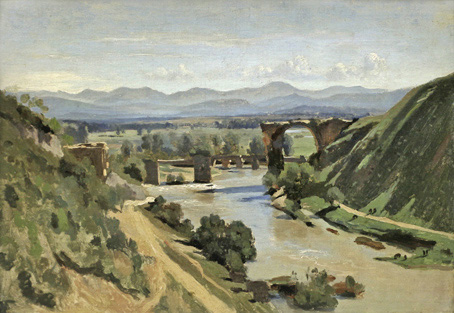
Le pont Augustan à Narni
1826 - 34 x 48 cm - Oil on paper laminated on canvas
Musée du Louvre, Paris, France >
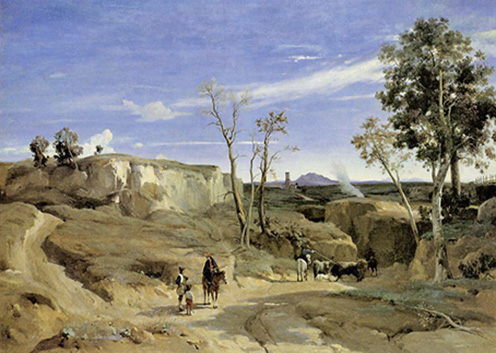
La Cervara, la campagne romaine
1830/31 - 98 x 136 cm - Oil on canvas
The Cleveland Museum of Art, Cleveland, USA >
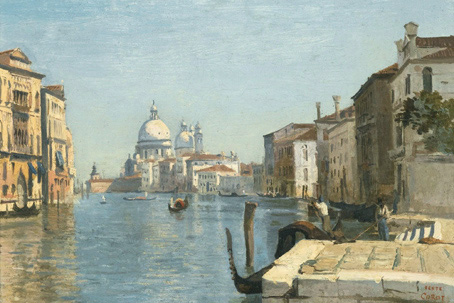
Venise - Vue du Campo della Carita en reardant le Dôme de la Salute
1834 - 26,7 x 38,1 cm - Oil on paper laminated on canvas
Privatsammlung
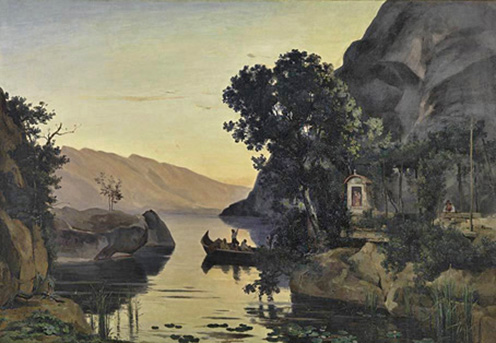
Paysage près de Riva sur le lac de Garde
1835 - 99 x 142 cm - Oil on canvas
Neue Pinakothek, München, Germany >
In France, he favoured open-air painting, which was not yet so common at the time, and returned to Fontainebleau. He was also drawn to Barbizon. He had a warm friendship with the painters there, especially Charles-François Daubigny and Theodore Rousseau. But none of them could succeed in the poetry of his pictures.
Officially, however, he painted in a historical style, but was initially not very successful with it. He increasingly painted portraits. From 1843, the tide turned and he began to be recognised.
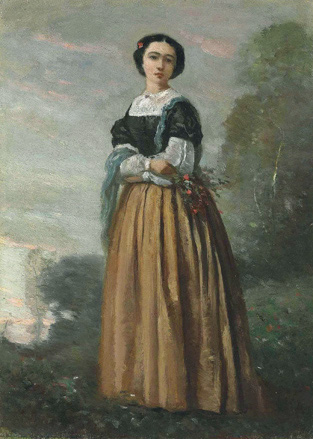
Portrait de femme a pied
1840 - 31,7 x 22,8 cm - Oil on canvas
Privatsammlung
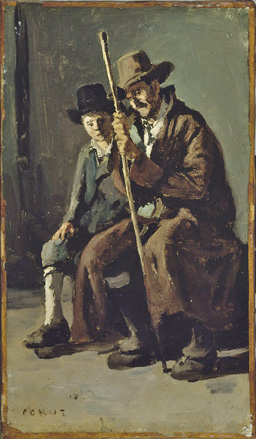
Deux paysans italiens
ca. 1843 - 29,5 x 17, 8 cm - Oil on canvas
The Walters Art Museum, Baltimore, USA >
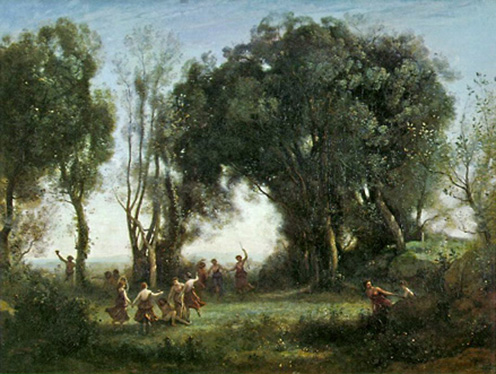
Une matinée, la danse des nymphes
ca. 1850 - 130 x 97 cm - Oil on canvas
Musée d'Orsay, Paris, France >
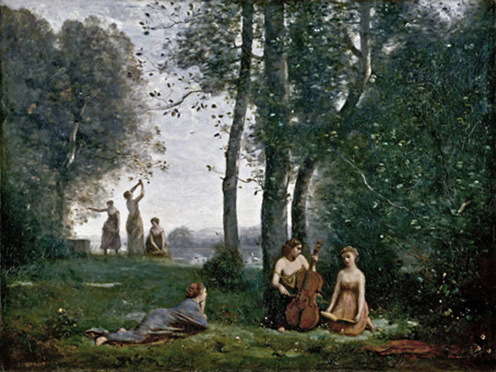
Le concert champêtre
1857 - 130 x 98 cm - Oil on canvas
Musée Condé, Chantilly, France >
He undertook a third trip to Italy in 1843, but by then he had already been recognised by critics and the public. Beaudelaire praised him publicly. In line with Constable's statement that painting should seek "the light, the dew, the breeze, the bloom and the freshness" and should therefore pay no attention to doctrines and systems, Corot left the well-trodden tracks of classicist academic painting and created a special depiction of light with its very own atmosphere. However, he was very reticent about publicising this painting and only showed it to the public very late in his life.
His landscape paintings can be seen as a kind of prologue to Impressionism.
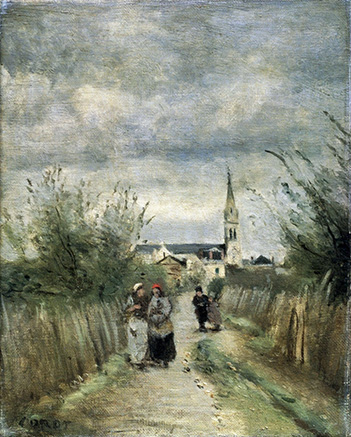
Clocher à Argenteuil (Chemin de l'église)
1855/60 - 33 x 17 cm - Oil on canvas
Pushkin Museum, Moskau, Russia >
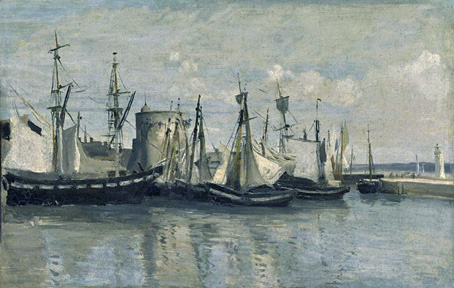
La Rochelle. Entrée du port d'échouage
1851 - 27 x 42 cm - Oil on canvas
Musée du Louvre, Paris, France >
His breakthrough came in 1855, when he presented his paintings labelled 'poetic landscape', which could not be assigned to any old school; they were free of any external influence. His palette consisted of a few tonal colours: Grey, ochre, brown and shades of green, in a particular expression of painting style. In his paintings, he achieves an atmosphere of rural solitude and enchanted tranquillity.

Ambiance matinale sur le lac de Garde
Ca. 1868 - 45 x 66 cm - Oil on canvas
Hamburger Kunsthalle, Germany >
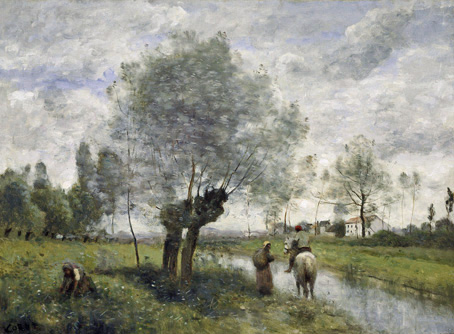
Paysage à Coubron
1870/72 - 40 x 54 cm - Oil on canvas
National Galleries Scotland, Edinburgh, Scotland >
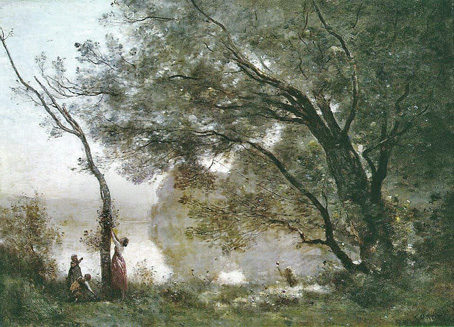
Recollection of Mortefontaine
1864 - 65 x 89 cm - Oil on canvas
Musée du Louvre, Paris, France >
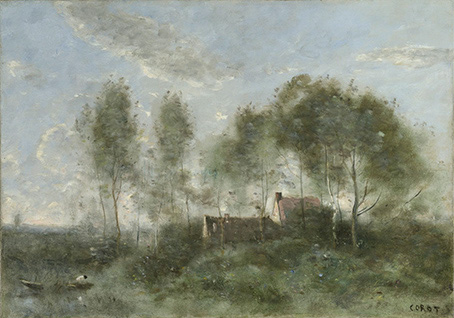
Souvenir d'un voyage à Combron
1873 - 32,4 x 46 cm - Oil on canvas
The National Gallery, London, United Kingdom >
It is a sensitive and warm-hearted painting, in art and technique a very unique style, like his whole being! The clarity, honesty and subtlety of his magnificent works, which are characterised by idyllic tranquillity and a pious serenity, reveal the poignant certainty of a gifted eye. One senses a myth of immortality in his works.
"confiance et conscience"
was his motto (Confidence and Conscience)
Courbet and Corot were on friendly terms, although Courbet expressed his overflowing ego by saying that he was the greatest of all living painters and that Corot was a distant second. Courbet once watched Corot painting in the open countryside and then remarked: "I don't see any people here as far and wide as they are in the picture!" To which Corot simply replied: "I can see them!"
More landscape paintings:
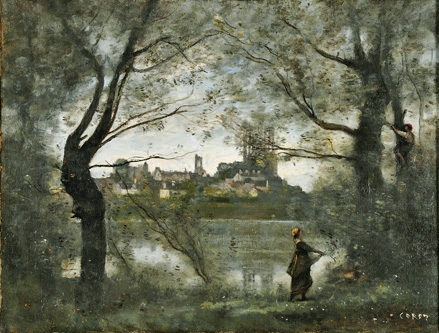
Mantes (le soir)
1860/65 - 43 x 56 cm - Oil on canvas
Musée des Beaux-Arts, Reims, France >

Le pont de Mantes
1868/70 - 38 x 55 cm - Oil on canvas
Musée du Louvre, Paris, France >
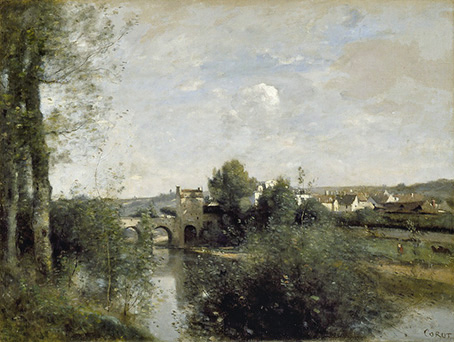
Seine et le vieux pont à Limay
1872 - 41 x 66 cm - Oil on canvas
Los Angeles County Museum of Art, Los Angeles, USA >
Gout dominated his work in the last years of his life. He now painted more portraits of women. He approached all his portraits - including the earlier ones - as he did his landscapes: looking, letting them be, trying to fathom their essence and paying attention to his own feelings.
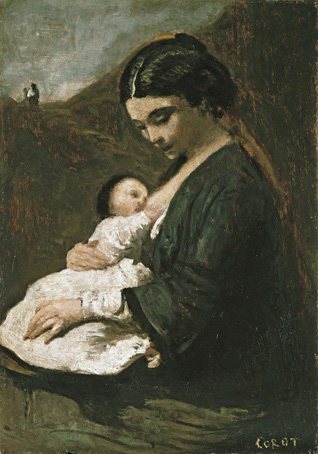
Mère et l'enfant
ca. 1860 - 32,4 x 22,5 cm - Oil on wood
The Metropolitan Museum of Art, New York, USA >
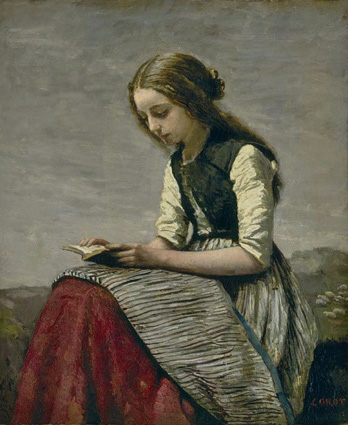
La petite liseuse
ca. 1855/61 - 46 x 38 cm - Oil on canvas
Sammlung Oskar Reinhart «Am Römerholz», Winterthur, Suisse >
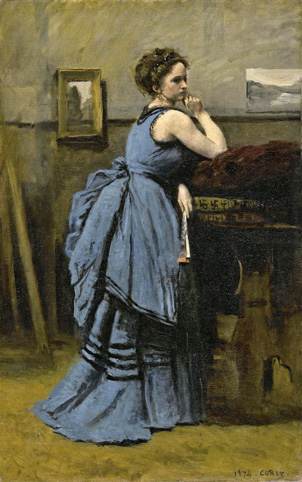
La dame en bleu
1874 - 80 x 50 cm - Oil on canvas
Musée du Louvre, Paris, France >
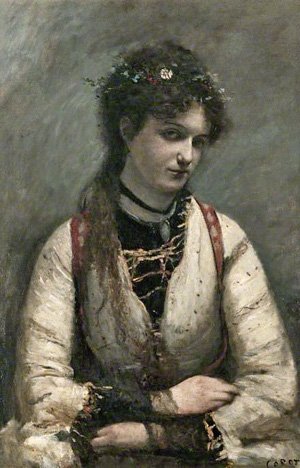
Mademoiselle de Foudras
1872 - 89 x 60 cm - Oil on canvas
Kelvingrowe Art Gallery and Museums, Glasgow, Scotland >
Corot died in 1875, one year after the first Impressionist exhibition. His painting was not yet part of this revolutionary style, but he probably had an influence on it and is considered a forerunner. For Manet, Bonnard, Renoir, Sisley and van Gogh, among others, he was a great and honest role model, with his related artistic impulses and views.
A few more examples from Corot's multifaceted oeuvre:
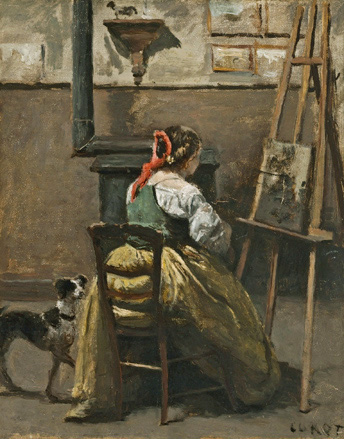
Studio d'artiste
1865/68 - 41 x 33 cm - Oil on wood
Baltimore Museum of Art, Baltimore, USA >
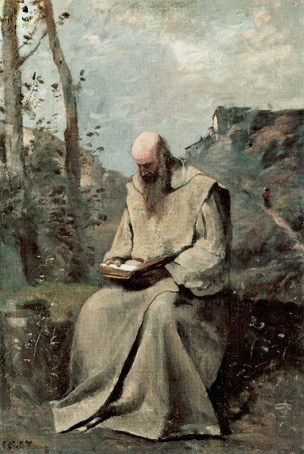
Assis Moine, Lecture
ca. 1865 - 73 x 50 cm - Oil on canvas
Stiftung Sammlung E. G. Bührle, Kunsthaus Zürich, Suisse >
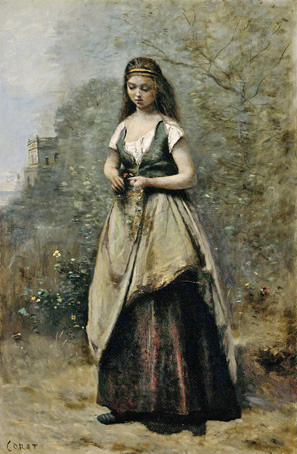
Jeune femme tissant une gerbe de fleurs
1866/70 - 70 x 47 cm - Oil on canvas
Museum of Fine Arts, Boston, USA >
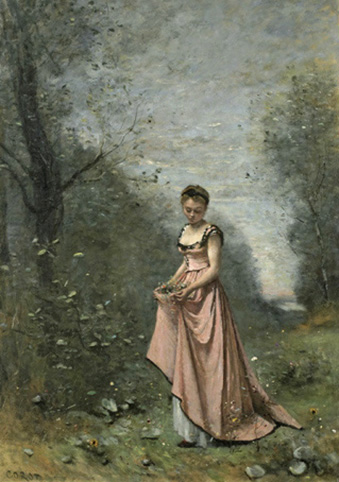
Printemps de la vie
1871 - 105 x 75 cm - Oil on canvas
Minneapolis Institute of Arts, Minneapolis, USA >
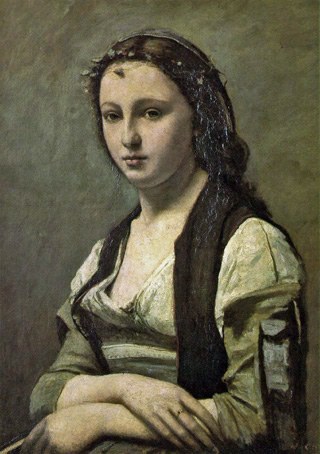
Fille à la perle
1875 - 70 x 55 cm - Oil on canvas
Musée du Louvre, Paris, France >
As was customary at the time, the nude was also an important theme,
albeit in a mythical guise.
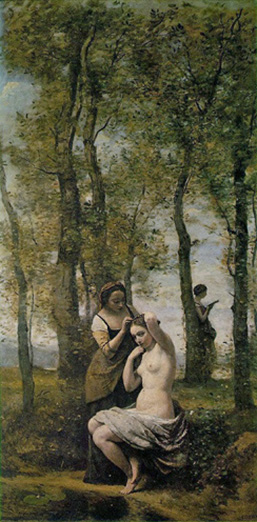
La Toilette
1859 - 173 x 87 cm - Oil on canvas
Private Property
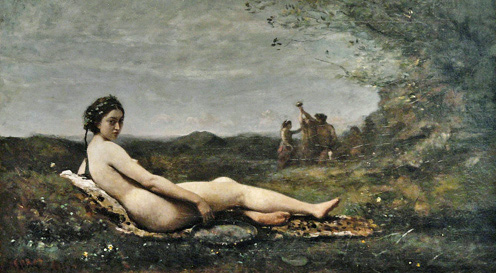
Repose
1860 - 58 x 102 cm - Oil on canvas
National Gallery of Art, Washington, USA >
A few examples of graphic work
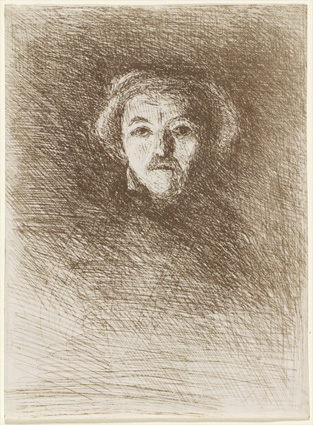
Selbstporträt
1858 - 21,7 x 15,8 cm - Glass plate printing
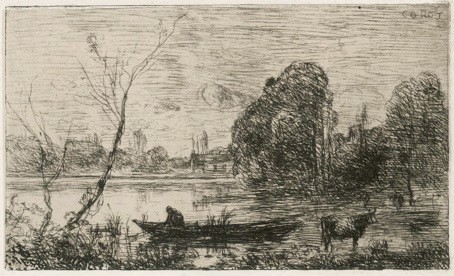
Ville d'Avray (Batelier sur étang
1862 - 7,2 x 12,3 cm - Etching
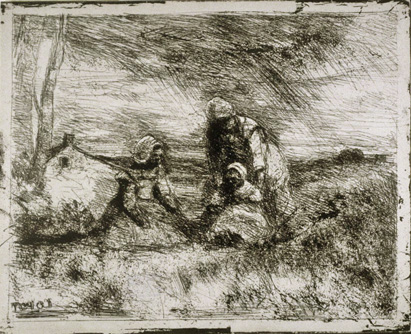
La Petite Sœur
1854 - 16,8 x 20,3 cm - Glass plate printing
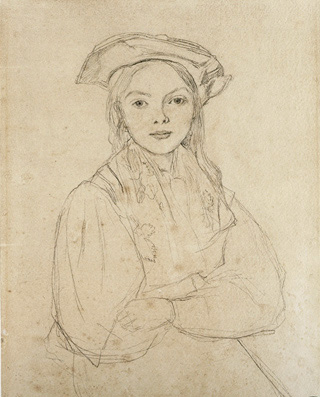
Jeune fille au béret
1831 - 29 x 22,2 cm - Pencil drawing
Corot painting near Saint-Nicolas-les-Arras ca. 1871:
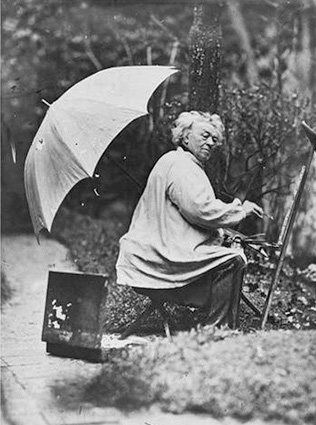
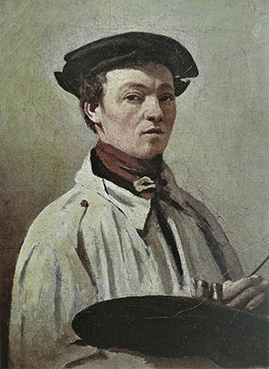
Selbstbildnis
ca. 1835 - 33 x 25 cm - Oil on cardboard
Galleria degli Uffizi, Florenz >
Ingres / Delacroix |
Gustave Courbet |
|
|---|---|---|
Imprint |